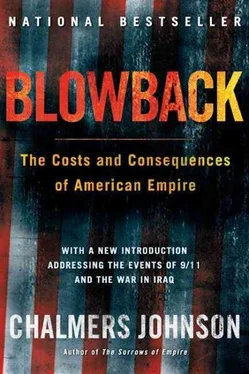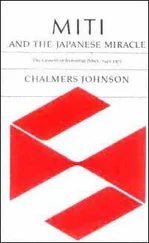Chalmers Johnson - Blowback, Second Edition - The Costs and Consequences of American Empire
Здесь есть возможность читать онлайн «Chalmers Johnson - Blowback, Second Edition - The Costs and Consequences of American Empire» весь текст электронной книги совершенно бесплатно (целиком полную версию без сокращений). В некоторых случаях можно слушать аудио, скачать через торрент в формате fb2 и присутствует краткое содержание. Год выпуска: 0101, ISBN: 0101, Издательство: Macmillan, Жанр: Старинная литература, на английском языке. Описание произведения, (предисловие) а так же отзывы посетителей доступны на портале библиотеки ЛибКат.
- Название:Blowback, Second Edition: The Costs and Consequences of American Empire
- Автор:
- Издательство:Macmillan
- Жанр:
- Год:0101
- ISBN:9780805075595
- Рейтинг книги:5 / 5. Голосов: 1
-
Избранное:Добавить в избранное
- Отзывы:
-
Ваша оценка:
- 100
- 1
- 2
- 3
- 4
- 5
Blowback, Second Edition: The Costs and Consequences of American Empire: краткое содержание, описание и аннотация
Предлагаем к чтению аннотацию, описание, краткое содержание или предисловие (зависит от того, что написал сам автор книги «Blowback, Second Edition: The Costs and Consequences of American Empire»). Если вы не нашли необходимую информацию о книге — напишите в комментариях, мы постараемся отыскать её.
Blowback, Second Edition: The Costs and Consequences of American Empire — читать онлайн бесплатно полную книгу (весь текст) целиком
Ниже представлен текст книги, разбитый по страницам. Система сохранения места последней прочитанной страницы, позволяет с удобством читать онлайн бесплатно книгу «Blowback, Second Edition: The Costs and Consequences of American Empire», без необходимости каждый раз заново искать на чём Вы остановились. Поставьте закладку, и сможете в любой момент перейти на страницу, на которой закончили чтение.
Интервал:
Закладка:
It turned out that the North Koreans had used a three-stage rocket to launch a rather modestly designed satellite in connection with the celebration of the country’s fiftieth anniversary. Like the famous 1970 Chinese satellite that broadcast the Maoist anthem “The East Is Red” into outer space, Pyongyang Radio announced that its satellite was transmitting the “Song of General Kim Il-sung” and “Song of General Kim Jong-il,” which it labeled “immortal revolutionary hymns.” The satellite seems to have malfunctioned, and no one ever recorded these melodies. The North Korean foreign ministry also pointedly added, “We have never criticized the United States and Japan for having launched artificial satellites. We are well aware that these satellites have been used for espionage on our country.” 10Japan has in fact launched at least twenty-four satellites since its National Space Development Agency was founded in 1969. The Japanese (and Americans) also failed to mention that this was only the fourth North Korean missile firing on record and only the second in the 1990s, five years after the test of the Nodong 1 in May 1993. It also did not mention Japan’s own highly developed rocket program, including a behemoth called the H-2, which has a payload of 5 tons, considerably greater than the 3.8 tons the United States’ MX Peacekeeper ICBM can lift. This is not to imply that the North’s missile was not threatening, only that it was most plausibly an attempt to deter much more formidable strategic forces deployed against it by the United States and Japan.
The United States has continued to harp on the threat posed by North Korea’s missile capability. It ostentatiously flew B-52 and B-2 strategic bombers to its Pacific bases in Guam. Among the reasons for this belligerence was a desire on the part of the Defense Department and the arms industry to continue working on an antimissile defense system, an idea now considerably scaled down from the Reagan administration’s lasers in outer space but still devoted to intercepting an incoming missile by firing a defensive missile at it. The technological requirements of hitting a bullet with another bullet are fierce, and there is always a possibility that nuclear fallout and debris from a successful interception will kill more people than if the warhead had been allowed to proceed to its target.
The American government has so far spent billions trying to make the theater missile defense (TMD) work but has repeatedly met with failure. One of the things it had most wanted was to get the Japanese to help fund the project (which even if it does not work will be very lucrative for the companies trying to build it) and provide technical input into it. The Japanese had consistently balked. The TMD seemed to them a probable violation of the Anti–Ballistic Missile Treaty and, in terms of deterrence theory, utterly destabilizing. If one country should ever achieve a successful missile defense (or believe that it had), it would have a strong incentive to launch a preemptive strike against its opponents before they too achieved such a defense. This is the main reason why China has consistently denounced America’s infatuation with the TMD, as well as because it does not want to be drawn into a ruinously expensive arms race to develop it.
North Korea’s launch of a missile with a range of several thousand miles transformed this debate. The Japanese finally agreed to buy into the TMD. On September 20,1998, to the jubilation of Secretary of State Madeleine Albright and Secretary of Defense William Cohen, Japan reversed itself and joined the missile defense research program. Whether Japan and the United States together will ever overcome the stupendous technological problems, not to mention the strategic issues of decoys, reliability, lack of defense against cruise missiles (because they fly too low), the ability to deliver weapons of mass destruction through much less sophisticated ways than missiles (for example, via boats, helicopters, airliners), and the likelihood that civilian populations will never actually trust defensive missiles are all open questions, to say the least. The history of the Cold War demonstrated that stable, credible deterrence is the only rational answer to weapons against which there is no defense. Nonetheless, the North Korean missile launch, together with evidence that North Korea is working on even longer-range missiles, gave great renewed impetus to the TMD idea.
The unraveling of the Agreed Framework was not entirely caused by Pyongyang. The drumbeat demonizing North Korea has continued unabated in Washington. In February 1999, Republican congressman Benjamin Gilman, chairman of the House International Relations Committee, was convinced that “North Korea could nuke Seattle,” and the director of central intelligence, George Tenet, testifying before the Senate Armed Services Committee, told the senators, “I can hardly overstate my concern about North Korea.” 11It seemed evident in the spring of 1999 that North Korea was being groomed as Public Enemy Number One until events in Yugoslavia overtook this campaign.
Even though it remains a small, failed Communist regime whose people are starving and have no petroleum, North Korea is a useful whipping boy for any number of interests in Washington. If the military needs a post–Cold War opponent to justify its existence, North Korea is less risky than China. Politicians seek partisan advantage by claiming that others are “soft” on defending the country from “rogue regimes.” And the arms lobby had a direct interest in selling its products to each and every nation in East Asia, regardless of its political orientation.
There is considerable evidence that since the signing of the Agreed Framework in 1994, a series of mysterious incidents has been created deliberately to undermine diplomatic efforts to reduce tensions. In September 1997, for instance, the United States, South Korea, China, and North Korea were scheduled to hold negotiations on replacing the forty-five-year-old Korean armistice with a peace treaty. In the same month the United States also said it hoped to obtain North Korea’s adherence to an international agreement first negotiated in 1987 called the Missile Technology Control Regime. This agreement sought to bring under control the transfer of technologies that could be used to make intercontinental ballistic missiles. The United States had indicated in advance that it would lift some of its economic sanctions against North Korea if it would halt deployment and sales of its missiles.
On August 22, 1997, the eve of the talks, the North Korean ambassador to Egypt, a key player in North Korea’s missile sales to the Middle East, “defected” to the United States. R. Jeffrey Smith, a reporter for the Washington Post , quoted a CIA source as saying, “There will be people in the intelligence community who will be salivating to see this guy.” 12In the New York Times Steven Lee Myers noted that the defection threatened the peace talks but quoted another U.S. official as saying, “The alternative of turning down a bona fide plea for asylum from a state like North Korea is pretty unthinkable.” 13Jamie Rubin, a State Department spokesman, insisted that the defection “will not affect the four-party peace talks.” 14Then Newsweek revealed that the former ambassador had in fact long been on the CIA’s payroll. 15Informed observers concluded that he had not so much defected as been called in from the cold at a time of the CIA’s choosing and with an eye toward scuttling the upcoming talks. North Korea in retaliation declined to attend either set of scheduled meetings.
A year later, amid reports that North Korea had grown frustrated with the failure of the United States to normalize relations, the New York Times published a front-page article by David E. Sanger—“North Korea Site an A-Bomb Plant, U.S. Agencies Say”—which revealed that “United States intelligence agencies have detected a huge secret underground complex in North Korea that they believe is the centerpiece of an effort to revive the country’s frozen nuclear weapons program, according to officials who have been briefed on the intelligence information.” 16Congressional sources later revealed that Sanger’s source was unanalyzed intelligence photographs probably leaked by Lt. Gen. Patrick Hughes, chief of the Defense Intelligence Agency. According to congressional aides, General Hughes regularly passed on information about the site, later identified as Kumchang-ri, to Republican congressmen. 17None of the Times ’s reporting on this incident ever cited a single government official by name, relying instead on the “blind quote”: “high government officials say,” “sources close to the White House reveal,” “members of the intelligence community disclose,” and so forth.
Читать дальшеИнтервал:
Закладка:
Похожие книги на «Blowback, Second Edition: The Costs and Consequences of American Empire»
Представляем Вашему вниманию похожие книги на «Blowback, Second Edition: The Costs and Consequences of American Empire» списком для выбора. Мы отобрали схожую по названию и смыслу литературу в надежде предоставить читателям больше вариантов отыскать новые, интересные, ещё непрочитанные произведения.
Обсуждение, отзывы о книге «Blowback, Second Edition: The Costs and Consequences of American Empire» и просто собственные мнения читателей. Оставьте ваши комментарии, напишите, что Вы думаете о произведении, его смысле или главных героях. Укажите что конкретно понравилось, а что нет, и почему Вы так считаете.










